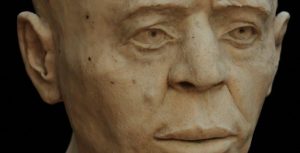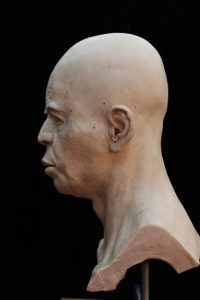The face of a man who lived 9500 years ago in Neolithic settlement in Jericho, now the West Bank region of Palestine, was reconstructed in British Museum.

The skull that served for reconstruction supposedly belonged to someone of great importance in his day, based on the amount of care people took to fill his skull with plaster when he was buried. In a ritual burial tradition common back in 8200-7500 BC the skull was filled with plaster, then decorated by adding a layer of paint and having shells inserted into the eye sockets. It is one of the best examples of these early burial practices, though not much more about the man is truly known.

In order to create the reconstruction, the skull was scanned at the Imaging and Analysis Centre at the Natural History Museum, where a complete micro-CT scan revealed new information and also provided a 3D model. The scan revealed that the plastered skull had decaying teeth, a broken nose earlier in life and that the skull was modified through binding and thus artificially elongating it during infancy.

(after Science Alert & Trustees of the British Museum)